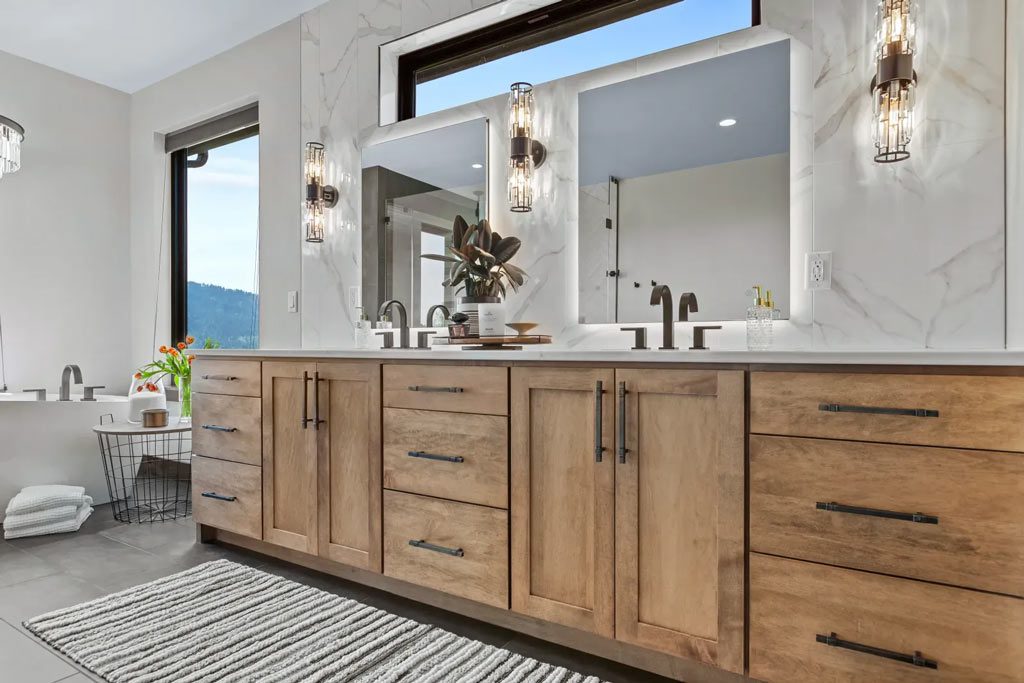1. Traditional Bathroom Style: Classic Sophistication
Key Characteristics of Traditional Bathrooms
The Traditional bathroom style is synonymous with elegance and timeless appeal. Rooted in classic design, these bathrooms often feature intricate detailing, luxurious materials, and a warm, inviting atmosphere.
Design Elements:
- Fixtures: Traditional bathrooms typically include classic fixtures such as clawfoot tubs, pedestal sinks, and porcelain or ceramic elements. These features often have a vintage or antique feel, with rounded shapes and ornate designs.
- Cabinetry: Furniture-style vanities with raised-panel doors and decorative molding are common in traditional bathrooms. Wood finishes, especially in rich tones like cherry, mahogany, or walnut, add warmth and depth to the space.
- Tile Work: Traditional bathrooms often showcase intricate tile patterns, such as herringbone or basketweave designs, using materials like marble or ceramic. Wainscoting or beadboard paneling is also a frequent feature.
- Color Palette: Neutral tones, such as whites, creams, and soft pastels, dominate traditional bathroom color schemes. Accents of gold, bronze, or deep blues can be used to add a touch of luxury.
- Hardware: The use of polished chrome, brushed nickel, or antique brass for faucets, towel bars, and drawer pulls enhances the classic look.
- Lighting: Chandeliers, sconces, and recessed lighting with ornate details and warm, soft lighting are typical in traditional bathrooms.
Layout Considerations:
Traditional bathrooms often emphasize symmetry and balance. A central focal point, such as a freestanding tub or an elegant vanity, anchors the design, with other elements arranged around it.
2. Contemporary Bathroom Style: Sleek and Modern
Key Characteristics of Contemporary Bathrooms
The Contemporary bathroom style is defined by its minimalist design, clean lines, and emphasis on function. These bathrooms exude a sleek, modern look, often incorporating the latest technology and innovative materials.
Design Elements:
- Fixtures: Contemporary bathrooms feature streamlined fixtures with simple, geometric shapes. Floating vanities, frameless glass shower enclosures, and wall-mounted faucets are popular choices.
- Materials: High-gloss finishes, glass, stainless steel, and engineered stone are common in contemporary bathrooms. The emphasis is on sleek, reflective surfaces that create a sense of openness.
- Color Palette: Neutral and monochromatic color schemes dominate contemporary bathrooms, with shades of white, gray, black, and occasionally bold accents like navy or deep green. The focus is on simplicity and contrast.
- Tile Work: Large-format tiles in neutral tones are often used, with minimal grout lines to enhance the sleek, uninterrupted look. Glass or mosaic tiles might be used as accents.
- Hardware: Chrome and brushed nickel are the go-to finishes for contemporary hardware, which often features minimalist designs with clean edges.
- Lighting: Recessed lighting, LED strips, and minimalistic pendant lights provide ample illumination while maintaining a modern aesthetic. Lighting is often integrated into mirrors or under cabinets for a subtle glow.
Layout Considerations:
Contemporary bathrooms prioritize functionality and efficient use of space. Open, airy layouts with minimal visual clutter are key, often featuring floating vanities and wall-mounted storage to create a sense of space.
3. Transitional Bathroom Style: The Perfect Blend
Key Characteristics of Transitional Bathrooms
The Transitional bathroom style combines elements of both Traditional and Contemporary designs, creating a balanced, versatile look that appeals to a wide range of tastes. This style is ideal for those who appreciate the classic elegance of traditional design but also want the clean lines and modern touches of contemporary bathrooms.
Design Elements:
- Fixtures: Transitional bathrooms might include a mix of classic and modern fixtures, such as a sleek, modern sink paired with a more traditional bathtub. The design focuses on blending rather than contrasting.
- Cabinetry: Transitional cabinetry often features clean lines with subtle decorative elements. Shaker-style cabinets are a popular choice, as they offer a simple, timeless look that works well in both traditional and modern settings.
- Materials: A mix of natural and engineered materials is common in transitional bathrooms. For example, a marble countertop might be paired with a modern glass tile backsplash.
- Color Palette: The color palette in transitional bathrooms is typically neutral, with a focus on soft, calming tones like gray, beige, and white. This allows for flexibility in adding either traditional or contemporary accents.
- Hardware: Transitional hardware combines the best of both worlds, with designs that are neither too ornate nor too minimalist. Brushed nickel, polished chrome, and oil-rubbed bronze are all common choices.
- Lighting: Lighting in a transitional bathroom is both functional and stylish. You might find a combination of traditional sconces paired with contemporary recessed lighting, providing both ambiance and practicality.
Layout Considerations:
Transitional bathrooms aim for a balanced layout that feels both comfortable and uncluttered. The design often includes a mix of open and closed storage, offering both the warmth of a traditional space and the efficiency of a modern one.
Conclusion: Choosing the Right Bathroom Style
Selecting the right bathroom style is a personal decision that depends on your taste, lifestyle, and the overall design of your home. Whether you prefer the classic sophistication of a Traditional bathroom, the sleek minimalism of a Contemporary one, or the balanced approach of a Transitional design, Eikos Kitchen + Bath Design studio can help you understand the key characteristics of each style and will help you create a space that is both beautiful and functional.



